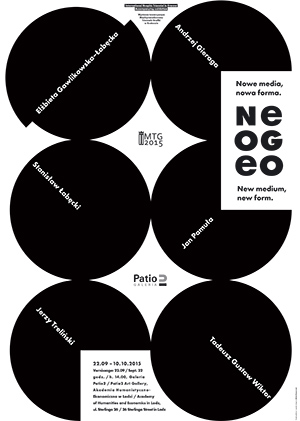Patio2 Art Gallery, Academy of Humanities and Economics in Lodz
26 Sterlinga Street, Lodz
see the map
22.09.2015 – 10.10.2015
vernissage: 22.09.2015, 14:00

Neogeo - New Media, New Form
Geometric Trends In Graphics And The Influence Of New Media On Form Shaping
Avant-garde of the 20s and 30s of the 20th century – constructivism has made of print and graphic designing a tool, whose aim was to pass the audience a matter-of-fact message through the text of a statement (posters, proclamations, manifestos, announcements, or polemics) and its graphic form. Composition based on mathematic relations and quantities became important. In this way graphic designing on the one hand approached engineering design, construction rooted in mathematic proportions and cool objectivity. Art wanted to become equal with matter-of-fact functionalism, be a practical response to the changing, industrial reality of the developing cities, industry, and technicization of life. At the same time it ought to be emphasized that the avant-garde reached for traditions lying at the foundations of art, namely for the idea of measure, harmony, and quantity. Interest in perfect proportions resurfaced, based on objective mathematic, and golden ratio was submitted to contemporary analysis. It can be pointed out that the art of those times united thoroughly modern elements with remote tradition of art foundations, and at the same time it combined intellectual elements with spiritual ones - even rational objectivity of mathematics had spiritual ideal in it.
Functional print constituted a significant change within the applied projects concept. It contributed to development of compositions based on geometry laws and mathematic proportions. Putting in order spatial relations and interaction of elements changed the language of graphic designing. Before World War II, and after its end, special place for the development of graphics in Poland was Łódź. The leading artist here was of course Władysław Strzemiński, and in time his disciples and successors. Many of contemporary graphic designing rules can be traced back to the concepts that originated and were developed in those times. Lodz circle originated such artists as: Jerzy Treliński, Stanisław Łabęcki, Elżbieta Gawlikowska-Łabęcka, and Andrzej Gieraga. Geometry, symbol, or proportion in their works are interpreted in many ways, but they always remain an important element of composition.
Jerzy Terliński's works presented at the exhibition recall the tradition of searching for the perfect proportion and the relation of composition and background elements. This is a conceptual dialog with the tradition of painting (for which the artist is famous). In a sense these are theoretic and aesthetic contemplations at the same time.
Stanislaw Łabęcki refers to a circle – an ideal shape of great symbolic and iconographic charge. Using colour relations, figure – contour relations, figure – background the artist solves composition problems connected to: perception of elements on a plane, relation of space and colour, perception changeability of composition elements. In this way he refers to the geometric language foundations of arts message – objective but also dependent on the audience's sensitivity, at the same time the artist refers to the tradition of arts language of such masters as Władysław Strzemiński or Wassily Kandinsky.
Today, graphics faces new challenges related to the language of the new media, technological transformations, use of digital print. These ensure new opportunities connected to multiplication. They facilitate experimenting within the forms of their mutual relations, proportions, arrangements, as well as colours relations, optical changes and space building with the use of colour contrasts. In the first place, examples in this area are works of Elżbieta Gawlikowska-Łabęcka. She reveals geometric arrangements which create a different art, spatial, and emotional expression each time they are multiplied and realized in different colour versions. It allows to notice how the use of a different colour for the same form changes tension between elements, establishes relation with the surroundings (by pushing forward or backward components of the work), or causes various moods in the audience. Through this a thoroughly intellectual and mathematically abstract art gains sensory and sensual character.
A similar situation is with the works of Andrzej Gieraga, who while remaining true to painting, employs geometric elements in his search for world's order, harmony, measure and quantity, in other words for elements closely connected to the idea of fine arts, antique tradition, but also to the 20th century avant-garde, in which what was real and mathematical was close to this, what was functional and utilitarian but also in a special way good and beautiful. His art deeply penetrates the fundamental rules of the world that are described by the artist with the use of painterly language of geometry, with enormous sensitivity to colour and its nuances, and with spiritual meditation of the most basic elements. Minimalism becomes a means of expressing the infinity and diversity of the world.
Cracow circle is represented at the exhibition by the works of Jan Pamuła and Tadeusz Gustaw Wiktor. Jan Pamuła's graphic accomplishments are rooted in the new media. They refer to repeatability and variability of element strings with the use of crashing, contrasting colours. Large-format works amaze and introduce the audience to the world of machines, diagrams, virtual reality consisting of colourful pixels, that haunts us with growing intensity.
On the other hand, works of Tadeusz Gustaw Wiktor in a way refer to cybernetic records of the machines, objective diagrams. At the same time significative meanings can be read in them, which constitute an interesting clash with synthetic form. Use of new technologies encourages search for objectivity in art, purity of rational forms, simplicity of geometry language, but at the same time leaves a margin for subjective interpretation of the audience.
Neogeo is a contemporary language of modern media, new technological opportunities related to multiplication of forms, almost machine-like precision of element repeatability, large formats, objective mathematics, but also an interest in harmonies and contrasts of colours. And behind all this a spiritual sensitivity to objective beauty realized through the language of geometry can be perceived.
Ewa Gałązka